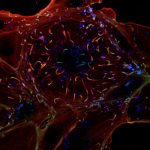About
Elucidating the mechanisms underlying cell deformation and motility is a topic of major interest in cell biology, for they are strongly involved in cell development, immune responses, cancer and infectious diseases. This projects focuses on the development robust and fully automated image analysis tools, able to extract quantitative measures of cell architecture, shape and motility from multi-dimensional (2D/3D), multi-modal (brightfield/phase-contrast/fluorescence) time-lapse microscopy data, with the aim to derive mathematical models of 3D cellular morphodynamics.
Working model: Entamoeba histolytica
Entamoeba histolytica, the causative agent of human amoebiasis, is a protozoan parasite characterised by its amoeboid motility, which is essential to its survival and invasion of the human host. Elucidating the molecular mechanisms leading to invasion of human tissues by of E. histolytica requires a quantitative understanding of how its cytoskeleton deforms and tailors its mode of migration to the local microenvironment. In this project we develop a fully interdisciplinary setting to tackle this challenge, placed at the interface between cell biology, biochemistry, fluorescence probe development, live cell imaging, and computational analysis & modelling, with the ultimate goal to decipher the morphodynamics and biomechanics of amoeboid motion in multiple experimental contexts, from simple in vitro models to complex reconstituted multi-cellular matrices.





